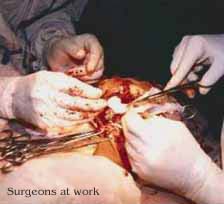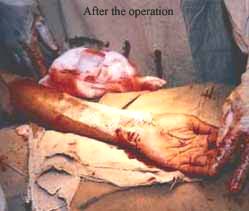
22nd October 2000
News/Comment|
Editorial/Opinion| Business| Sports|
Sports Plus| Mirror Magazine

A stitch, a drill in time saves a hand
By Kesara Ratnatunga
Headlines were made a few weeks ago when two men assaulted a youth from Raththota, near Matale.The reasons for this attack are still unclear. However, this incident though seemingly a case of common assault gained special attention because of the events that transpired within the hours following its occurrence.
 The
story begins at around 8 a.m. on Sunday September 3, when 21-year-old Ranjith
Kumara was at a bus stand waiting to go to work. Two men - one armed with
a sword - had allegedly jumped on him and cleanly chopped off his left
hand at the wrist joint.
The
story begins at around 8 a.m. on Sunday September 3, when 21-year-old Ranjith
Kumara was at a bus stand waiting to go to work. Two men - one armed with
a sword - had allegedly jumped on him and cleanly chopped off his left
hand at the wrist joint.
Minus a hand and bleeding profusely, he had screamed for help. The incident having taken place near his hometown, relatives had been able to quickly go to his aid and take him to the Matale hospital.
One person had luckily had the presence of mind to pick up the severed hand, place it in a clean bag and bring it to the hospital.
The Matale hospital staff had bandaged the stump to stop the bleeding, packed the hand in ice, given him an intra-venous line to resuscitate him, and transported him as fast as possible to the Peradeniya Teaching Hospital in Kandy.
By the time the patient arrived at the Peradeniya hospital, the time was around 11.30 a.m, just over three hours since the incident had occurred.
Dr. J. Anthony, the senior registrar had examined the patient and called Dr. Shaukat Esufali who was the duty surgeon that day. Dr. Esufali being the official doctor for the Kandy international rugby sevens happened to be at the Bogambara grounds when he received the call from his senior registrar.
 "Because
it was a young man and a clean cut with only three hours having gone by,
I thought it would be a good idea to try and put the hand back together,"
said Dr. Esufali.
"Because
it was a young man and a clean cut with only three hours having gone by,
I thought it would be a good idea to try and put the hand back together,"
said Dr. Esufali.
Explaining the procedure Dr. Esufali said that the first step was to join the two main arteries to the hand. Each having the diameter of less than that of a match stick, they were sutured together using very fine thread.
"There are three main nerves which supply the hand," he said, "I managed to find the median nerve, the most important one which gives sensation to the hand, and join it up." Following this all the muscles and tendons that enable the movement of the fingers were repaired, the whole process so far taking about three-and-a-half hours. "We didn't use any special instruments or microscopes, it was free hand surgery."
The next step was to repair the damage to the bones and this was the job of the orthopaedic surgeon, Dr. Hilary Suraweera.
He needed to drill the bones and insert wires into them so as to hold the two pieces together since at the moment the hand and the rest of the arm were only connected by a few arteries, nerves and tendons.
"If we had let the hand drop, it would have just fallen off," said Dr. Esufali. Drilling the bones was a delicate procedure and required a minimum amount of jarring so as not to be too traumatic and damage the repair that had already been done. Therefore a manual drill could not be used and a power drill was required, which unfortunately the hospital did not have.
This was acquired for the procedure by Dr. Suraweera from a private hospital. Dr. Suraweera completed his work by successfully getting three pins through the finger bones and attaching them to the arm bones.
After the work on the bones was completed Dr. Esufali repaired the damage to two veins. "We couldn't find any more veins because the remainder were far too delicate, and we left it at that." It was now about four-and-a-half hours into the operation.
"We managed to get arterial blood flow within four to five hours, and the venous blood flow corrected by about seven hours. We were very happy, because at the end of the surgery the fingers were becoming pink and we were sure that the blood supply was intact."
Anaesthetising the patient for the operation had been a risky business since he had not been starving and could have vomited causing serious complications. However the urgency with which the operation had to be performed in order to save the hand, made it imperative that the procedure be performed immediately.
Dr. D. Ehelapola and Dr. Mrs. Udayangani Lekamge - the two anaesthetists - managed to successfully keep the patient anaesthetised for the duration of the operation without any complications.
The threat of infection has now been overcome and the next step on the road to recovery is the healing of the nerves, which will take about three to six months.
Ranjith Kumara is currently back at home and having undergone physiotherapy is able to partially move his fingers. "We plan to bring him back in about three months time and try to find the other nerves and any remaining tendons and try to join them up," said Dr. Esufali who is confident of up to an 80% recovery both in flexibility and strength of the hand.
According to him, overseas studies have shown that in the case of a re-implantation at the wrist, if blood flow is established within eight hours, the results are extremely good.
This is the first time that an operation of this nature has been performed in Kandy, and one of the few in Sri Lanka.
The success of the operation and recovery of the patient is heartening indeed and a fitting tribute to those whose skillful work on the operating table saved a young man from permanent disability.








![]()
Front Page| News/Comment| Editorial/Opinion| Plus| Business| Sports| Sports Plus| Mirror Magazine
Please send your comments and suggestions on this web site to

